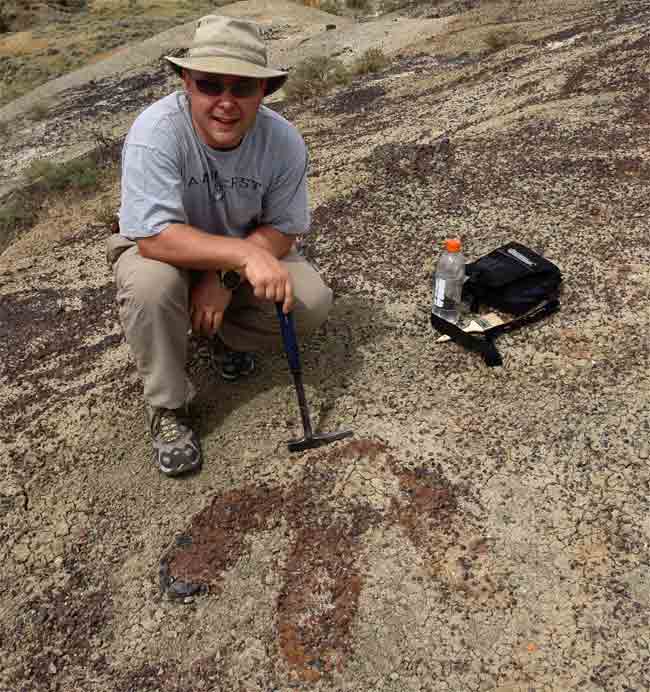Tyrannosaur Footprint Found in Montana

A paleontologist has discovered a giant footprint most likely left by a towering tyrannosaur as it pounded the Earth 65 million years ago.
The footprint, which measures about 2.5 feet (74 centimeters) in length, was found in rocks in Montana's Hell Creek Formation, a well-known site for Tyrannosaurus rex fossils.
"We are relatively confident that it's been made by a theropod, or predatory dinosaur," said paleontologist Phillip Manning of the University of Manchester in England, who was part of the team that found the print.
Based on the footprint's slender toes, toe positions and overall size, Manning and his colleagues have narrowed down the dinosaur's species name to either T. rex or Nanotyrannus, a tyrannosaur whose name means "tiny tyrant."
"Predatory dinosaurs have much more gracile toes than their dumpy hadrosaur [duck-billed dinosaur] friends that are lolloping around at the end of the Cretaceous," Manning told LiveScience.
T. rex is thought to have grown to about 40 feet (12 meters) in length, while Nanotyrannus was likely just about 17 feet (5 meters) long. Both dinosaurs lived 67 million to 65 million years ago at the end of the Cretaceous Period.
Of course there's always the possibility that a species of dinosaur that is new to science left the print, Manning said.
Get the world’s most fascinating discoveries delivered straight to your inbox.
A future discovery of a more pristine and unweathered footprint at the site, made by the same species, would also help in identifying the dinosaur that made the latest print.
"The only way you'd know whether an animal had left its footprint 65 million years ago in a specific package of rock would be to find the animal dead in its tracks," Manning said.
- Video: Dino Race
- Top 10 Deadliest Animals
- Image Gallery: Drawing Dinosaurs
Jeanna Bryner is managing editor of Scientific American. Previously she was editor in chief of Live Science and, prior to that, an editor at Scholastic's Science World magazine. Bryner has an English degree from Salisbury University, a master's degree in biogeochemistry and environmental sciences from the University of Maryland and a graduate science journalism degree from New York University. She has worked as a biologist in Florida, where she monitored wetlands and did field surveys for endangered species, including the gorgeous Florida Scrub Jay. She also received an ocean sciences journalism fellowship from the Woods Hole Oceanographic Institution. She is a firm believer that science is for everyone and that just about everything can be viewed through the lens of science.


